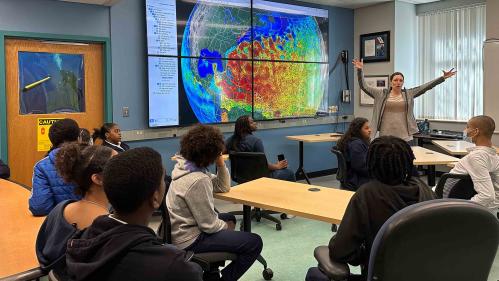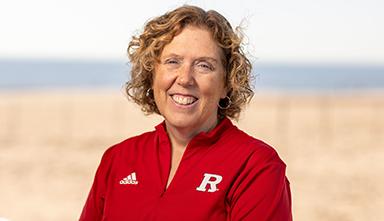Rutgers Is Making STEM Breakthroughs, One Student at a Time

A 4-H youth development program changes perceptions, making students insiders in science, technology, engineering and mathematics
Role models, often parents or other close family members, serve as crucial sources of inspiration for students engaged in making career choices in science, technology, engineering and mathematics (STEM), according to research studies.
A big part of what Janice McDonnell is doing with a program known as Rutgers 4-H STEM Ambassadors is to connect students without a STEM role model in their families or communities with working scientists.
McDonnell is an associate professor and Science Technology Engineering and Mathematics (STEM) Agent in the Department of 4-H Youth Development, at the Rutgers School of Environmental and Biological Sciences (SEBS). She runs the program, funded by Bristol Myers Squibb, with Chad Ripberger, the county extension department head of the Rutgers Cooperative Extension of Mercer County.
McDonnell discussed the importance of the STEM Ambassadors program.

What do most students you’re working with – those aged 13 to 18 – think about science and math? Have you encountered any views that surprised you?
In our experience, most of our young people don’t have a broad or informed perspective on science and mathematics or career pathways in STEM fields. This is not unexpected, as many of our participants don’t have local role models in STEM and come from under-resourced communities that don’t have a lot of access to STEM opportunities. Research shows that underserved students perceive themselves as STEM outsiders.
Our program creates STEM “insiders” by changing perceptions. We introduce our ambassadors to scientific inquiry and provide a firsthand learning experience in Rutgers laboratories and local field sites like the Rutgers Gardens. Scientists and engineers talk with our ambassadors about what it is like to be a STEM professional and normalize challenges.
Failure and unexpected results, they find out, are part of learning, and the process of answering interesting scientific questions is iterative and takes time. Most importantly, exposure is the key for our STEM ambassadors. We often hear, “I didn't know this was an option for me.”
Why is there a need for the program and what does it do?
Since its inception in 2009, the Rutgers 4-H STEM Ambassadors program has engaged over 550 high school students in year-round experiences designed to promote STEM identity and college readiness among those underrepresented in science and engineering.
Rutgers 4-H faculty and staff connect limited resource and first-generation students, primarily African American and Latino, to scientists and engineers across the entire university system as they work together to conduct research and tackle problems in a variety of STEM fields.
After an intensive residential program on campus in July, the 4-H STEM ambassadors return to their home communities to contribute a minimum of 50 hours of service each year, working with county-based faculty and staff to lead STEM experiences for youth in afterschool, Saturday and summer camp programs.
How do Rutgers faculty contribute to this program?
They are central to our success as a program. 4-H faculty and staff collaborate with faculty from several Rutgers schools to connect those from economically less advantaged communities to the university’s wealth of STEM resources. 4-H provides professional development for over 40 Rutgers scientists and engineers to engage with each cohort – providing authentic research opportunities, laboratory experiences, discussions, and mentorship.
4-H also involves the Rutgers Center for Mathematics, Science and Computer Education, the Math and Science Learning Center, Rutgers Makerspace and Rutgers Gardens to increase awareness and interest in STEM. Rutgers undergraduate and graduate students also serve as “near peer” mentors for our teens.
Can you provide examples of recent meaningful collaborations?
Recently, 4-H STEM ambassadors joined faculty at Rutgers for the 2023 Climate and Sustainability Summit for a day of learning, discovery, collaboration and action.
The 4-H summit, attended by 25 ambassadors, addressed the importance of being sustainable and fulfilling the needs of current generations without compromising the needs of future generations – ensuring a balance between economic growth, environmental care and social well-being.
Rutgers faculty facilitated discussions and hands-on activities on topics ranging from food systems to renewable energy to environmentally friendly infrastructure. The ambassadors were then given the challenge to take what they learned and turn it into an actionable plan back in their communities. Some youth will be presenting what they learned to local boards of education or local environmental groups, and some will use what they learned to teach younger students.
What success stories can you share?
Fortunately, we have a lot of success stories in the STEM Ambassador program. Many ambassadors end up attending college at Rutgers University. In a recent longitudinal study of our first 10 cohorts, 34 percent were attending Rutgers.
If not Rutgers, many go to other colleges and universities such as the University of Virginia, Harvard University, the University of Pennsylvania and Case Western Reserve University, to name a few.
Many of our ambassadors have gone into STEM fields such as environmental science, engineering, computer science and medical professions. Students have consistently credited the program for supporting their journey in STEM – building awareness, skills, and confidence.
One of our ambassadors told me, “My experiences have me interested in things that I never thought I would be interested in. Subjects I thought I loathed are subjects that I want to look into. This would not have been possible without the scientists I worked with."




